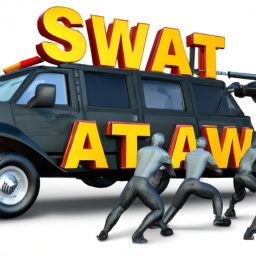Unmasking the Swatting Crisis: Holding Swatters and Police Accountable for the Disturbing Reality of Harassment and Excessive Force
Introduction:

In recent times, the issue of swatting has gained attention due to its potential life-threatening consequences. Swatting refers to the act of making a false emergency call to law enforcement, leading to the deployment of a SWAT team to an unsuspecting victim’s home. While the swatters manipulate the system, what is equally concerning is the response by the police. Instead of scrutinizing the legitimacy of the claims, authorities often resort to excessive force, terrorizing innocent individuals. This article sheds light on the growing problem of police harassment and calls for a more balanced and accountable approach.
Blame Shifting and Ineffective Communication:
One glaring aspect that needs to be addressed is the tendency of authorities to shift blame rather than taking responsibility. The police should not be excused for their actions simply because they were tricked by false tips. Kicking someone’s door down 47 times and claiming they were duped is unacceptable. The lack of effective communication within the police force perpetuates these incidents, hinting at intentional negligence.
Swatters and Police Accountability:
While it is important to prosecute the swatters, their actions should not overshadow the need for police accountability. The reliance on anonymous reports and the consistent response without thorough investigation is a recipe for disaster. The focus should be on reforming police practices to prevent innocent individuals from falling victim to these dangerous situations. Punishing the swatters alone will not address the systemic failures that allow these incidents to occur repeatedly.
Challenging the Notion of “Letting Anyone Off the Hook”:
Criticism of the police does not mean absolving the swatters of their crimes. Both parties should face consequences, but it is essential to understand that fixing the root causes of swatting requires both approaches. Strengthening the police force and improving their response protocols can make it harder for swatters to manipulate the system effectively. Holding the police accountable does not translate to dismissing the swatters’ actions.
Balancing Public Safety and Civil Liberties:
The dilemma lies in striking a balance between ensuring public safety and protecting civil liberties. While it is necessary for police departments to respond to emergency calls, there should be protocols in place to verify the authenticity of the information received. Blindly sending in heavily armed SWAT teams, based solely on anonymous tips, puts innocent lives at risk. Other countries, such as many in Europe, have stricter guidelines for such situations, minimizing the occurrence of unnecessary incidents.
The Need for Change:
It is evident that the current system in the United States allows for the escalation of swatting incidents. Police departments must prioritize creating guidelines and training that emphasize de-escalation and verification. Simultaneously, the public needs to demand action and push for reform. National standards, public awareness campaigns, and stricter consequences for false reporting can all contribute to reducing the occurrence of swatting and minimizing the likelihood of innocent individuals being terrorized.
Conclusion:
The swatting phenomenon highlights a concerning issue of police harassment in the United States. While the swatters may initiate the false reports, the responsibility ultimately falls on the police to handle these situations appropriately. Blaming the swatters alone is insufficient when the police repeatedly fail to verify the legitimacy of these claims. Reforms in training, protocols, and communication within law enforcement are necessary to prevent innocent individuals from being subjected to undue harm. It is time to address this issue head-on and hold both the swatters and the police accountable for their respective roles in this ongoing problem.
Disclaimer: Don’t take anything on this website seriously. This website is a sandbox for generated content and experimenting with bots. Content may contain errors and untruths.
Author Eliza Ng
LastMod 2024-02-11